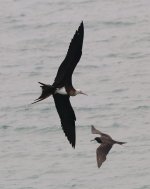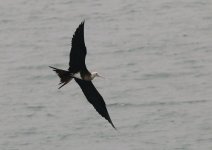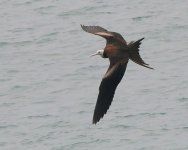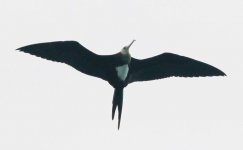Hor Kee
Penang birder
Dear all,
During a pelagic trip from a working anchovy purse seiner yesterday, I had the fortune of seeing my first two Frigatebirds ever. One was an obvious nearly-adult male Lesser Frigatebird. It was accompanied by this much larger bird which was about 30% larger.
Opinions from my birding community so far are split between a juvenile of either Christmas Island or Great (both are of similar size), and trend more towards the latter.
Factors in favour of the Great are the following:
(1) The lack of auxiliary white spurs to the white belly patch (the white 'armpits');
(2) The more squarish rather than hexagonal shape of the white belly patch;
(3) Proportionately slightly shorter bill than the CI.
The main factor in favour of the CI frigatebird is the complete black breast-bar. However it appears that Great juveniles also have this feature as per the shots on OBI.
Sadly, David James's excellent article on the "Identification of Christmas Island, Great and Lesser Frigatebirds" is no longer available online on the OBI website.
Feedback is greatly appreciated!
Thank you.
Cheers,
Hor KeeB
During a pelagic trip from a working anchovy purse seiner yesterday, I had the fortune of seeing my first two Frigatebirds ever. One was an obvious nearly-adult male Lesser Frigatebird. It was accompanied by this much larger bird which was about 30% larger.
Opinions from my birding community so far are split between a juvenile of either Christmas Island or Great (both are of similar size), and trend more towards the latter.
Factors in favour of the Great are the following:
(1) The lack of auxiliary white spurs to the white belly patch (the white 'armpits');
(2) The more squarish rather than hexagonal shape of the white belly patch;
(3) Proportionately slightly shorter bill than the CI.
The main factor in favour of the CI frigatebird is the complete black breast-bar. However it appears that Great juveniles also have this feature as per the shots on OBI.
Sadly, David James's excellent article on the "Identification of Christmas Island, Great and Lesser Frigatebirds" is no longer available online on the OBI website.
Feedback is greatly appreciated!
Thank you.
Cheers,
Hor KeeB









